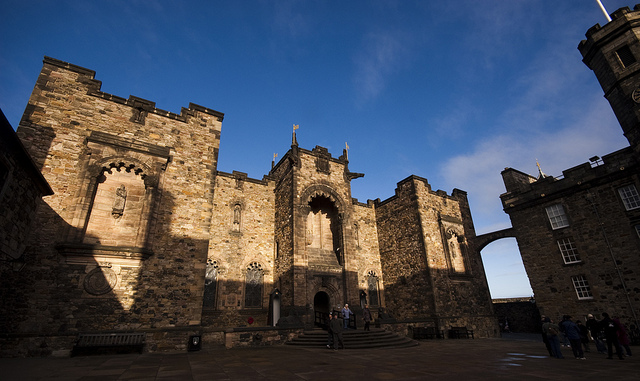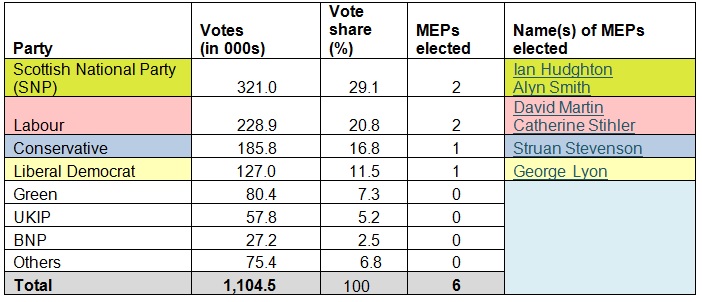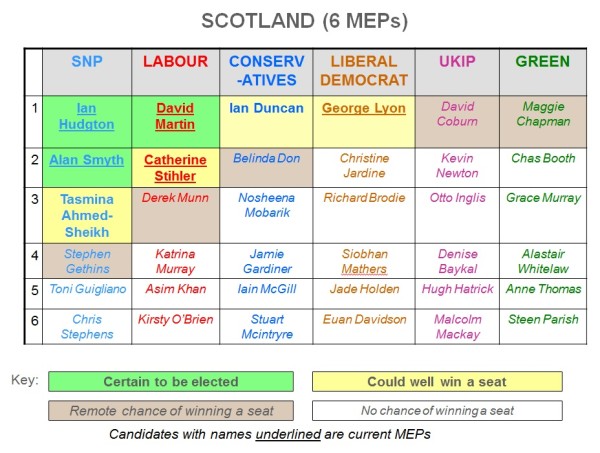Euro Elections – previewing the contest in Scotland
Continuing our series of articles on the forthcoming European Parliament elections, profiling each of the regional constituencies in turn, the Democratic Audit team looks at Scotland, which has six MEPs. We can expect to see the SNP top the ballot again, but with Labour next reviving compared to 2009, both likely to win two seats. The Conservatives, UKIP, the Liberal Democrats and the Scottish Green Party will be fighting hard for the two seats likely to be left.
Scotland has its own party system (with the Scottish National Party (SNP) currently running a majority government), its own Parliament and its own executive arrangements, so that a different set of pressures exert themselves here. The SNP is now a leading political force at Scottish Parliament level, while Labour have generally have the upper hand in all past Westminster elections, despite the increase in the SNP vote in recent years. While represented in the Scottish Parliament, the Conservatives are almost non-existent in Westminster terms. The Liberal Democrats, once visible if not strong in the Scottish Parliament, have been reduced to a rump there since the formation of the Con-Lib Dem coalition government at Westminster.
In European elections, since the introduction of the list PR system Labour and the SNP have vied for top spot, with Labour winning narrowly in 1999 and comfortably again in 2004, but the SNP winning well in 2009. The Conservatives have polled a relatively steady 15-20% during this period, while the Liberal Democrats have languished in fourth place on 9-13%. UKIP have not been a force in Scottish elections for the European Parliament up to the point. The Greens, likewise, have struggled to break past 5-6%.
What happened last time, June 2009
The SNP topped the poll but returned only 2 MEPs, the same number as Labour Party who finished (for them) a poor second. The third place Conservative Party gained a single MEP, as did the fourth place Liberal Democrats. The Scottish Greens did not do conspicuously well, not gaining enough votes to win a seat. And despite performing strongly in 2009 elsewhere in Britain, UKIP came in a distant sixth here, a long way off winning a seat.
Table 1: What happened last time, June 2009
Note: Our vote data are rounded to the nearest thousand votes. Exact 2009 results are available from UK Polling Report here. All but one of the incumbent MEPs are running for re-election, the exception being the Tories’ Struan Stevenson, who has stepped down.
What could happen next time?
At the 2011 Scottish Parliament election, the Liberal Democrat vote collapsed and the Scottish National Party went on to win a majority in the Parliament. The SNP will be hoping that the pattern repeats itself, with polling suggesting a strong showing from the pro-independence party. They are likely to emerge with at least two MEPs, and have at least a possibility of winning a third, given the current independence referendum tide. Labour, meanwhile, have revived compared to 2009, and will certainly finish at least a stronger second, so they can also expect to see two MEPs elected.
Table 2: Simplified ballot paper
The Conservatives have a small but reasonably consistent vote in Scotland, which should be enough to see them edge home with one MEP, assuming that their vote does not get damaged by UKIP. A second seat is out of the question. Scotland has been largely immune to the rise of UKIP, however they will be hoping for 2-3 per cent extra sypport from a probable collapse in the BNP vote, which might just be enough to challenge for their first seat. The Liberal Democrats have become very weak in Scotland since the formation of the Coalition. So it will be a surprise if they are able to hold onto their one Scottish MEP, although incumbency is a plus. The Green Party are in with an outside chance of winning their first European seat in Scotland, though it remains far from a probability.
The top parties’ candidates
![]()

 The number one Scottish National Party (SNP) candidate is the incumbent MEP Ian Hudghton. He was first elected as an MEP in 2004 at a by-election. The independent organisation Votewatch EU has detailed information about his activities in the European Parliament, where he is Vice-President of the European Free Alliance grouping, part of the Greens/EFA Group and a member of the Fisheries and the Internal Market & Consumer Protection Committees. He can be confident of his prospects of re-election. He is on Twitter, and his profile page is here. The second placed SNP candidate is Alyn Smith, also an incumbent MEP since 2004. Prior to his election he worked for the SNP in a number of capacities. In the European Parliament, he is a member of the Agriculture and Rural Development committee. More information about his activities in the Parliament can be found on his Votewatch EU site here. His Twitter account can be accessed here. If recent polling and electoral trends are taken into account Smith, too, can be confident of being re-elected. The third placed candidate for the party is Tasmina Ahmed-Sheikh. She is a lawyer, and has received an OBE for services to business. She was previously a member of both the Conservative and Labour Parties (at different times). Her Twitter account can be found here. She just might be elected if SNP support surges.
The number one Scottish National Party (SNP) candidate is the incumbent MEP Ian Hudghton. He was first elected as an MEP in 2004 at a by-election. The independent organisation Votewatch EU has detailed information about his activities in the European Parliament, where he is Vice-President of the European Free Alliance grouping, part of the Greens/EFA Group and a member of the Fisheries and the Internal Market & Consumer Protection Committees. He can be confident of his prospects of re-election. He is on Twitter, and his profile page is here. The second placed SNP candidate is Alyn Smith, also an incumbent MEP since 2004. Prior to his election he worked for the SNP in a number of capacities. In the European Parliament, he is a member of the Agriculture and Rural Development committee. More information about his activities in the Parliament can be found on his Votewatch EU site here. His Twitter account can be accessed here. If recent polling and electoral trends are taken into account Smith, too, can be confident of being re-elected. The third placed candidate for the party is Tasmina Ahmed-Sheikh. She is a lawyer, and has received an OBE for services to business. She was previously a member of both the Conservative and Labour Parties (at different times). Her Twitter account can be found here. She just might be elected if SNP support surges.


 Labour’s top candidate for Scotland is David Martin, who has been an MEP since 1984, when he represented Lothians (prior to the introduction of the reformed electoral system for European elections in 1999). He was formerly Labour’s leader in the European Parliament and a Vice-President of the European Parliament between 1984 and 2009. In 2002 he was the defeated Socialist candidate for the President of the Parliament. His Votewatch EU profile provides more information about his record and activities in the Parliament. He is also on Twitter, and can be almost assured of victory. Fellow incumbent MEP Catherine Stihler is second on Labour’s Scotland list. She has been an MEP since 1999, and was previous the President of the National Union of Students (NUS). She has served as the Deputy Leader of the EPLP and held positions as Labour’s European spokesperson on health and fisheries. She is currently Labour’s European spokesperson on consumer rights and serves on the economic and monetary affairs committee. Her Votewatch EU profile provides full details of her activities in the European Parliament. Her Twitter profile is here. In third place for Labour is Derek Munn. He has worked for the Labour Party in a number of different capacities, and as an adviser to the former First Minister of Scotland, Jack McConnell. He is unlikely to win, unless 2014 is a surprisingly good year for Labour in Scotland. He is on Twitter here.
Labour’s top candidate for Scotland is David Martin, who has been an MEP since 1984, when he represented Lothians (prior to the introduction of the reformed electoral system for European elections in 1999). He was formerly Labour’s leader in the European Parliament and a Vice-President of the European Parliament between 1984 and 2009. In 2002 he was the defeated Socialist candidate for the President of the Parliament. His Votewatch EU profile provides more information about his record and activities in the Parliament. He is also on Twitter, and can be almost assured of victory. Fellow incumbent MEP Catherine Stihler is second on Labour’s Scotland list. She has been an MEP since 1999, and was previous the President of the National Union of Students (NUS). She has served as the Deputy Leader of the EPLP and held positions as Labour’s European spokesperson on health and fisheries. She is currently Labour’s European spokesperson on consumer rights and serves on the economic and monetary affairs committee. Her Votewatch EU profile provides full details of her activities in the European Parliament. Her Twitter profile is here. In third place for Labour is Derek Munn. He has worked for the Labour Party in a number of different capacities, and as an adviser to the former First Minister of Scotland, Jack McConnell. He is unlikely to win, unless 2014 is a surprisingly good year for Labour in Scotland. He is on Twitter here.

 Topping the list for the Conservative Party is Dr Ian Duncan, who is aiming to replace the Tories’ outgoing MEP Struan Stephenson, and has a good chance of doing so. He was previously deputy chief executive of the Scottish Fishermen’s Federation, a position he held for four years, and later Head of Policy & Communication for the Scottish Refugee Council. He was also the head of the Scottish Parliament’s office in Brussels and latterly a clerk to the Parliament’s European Committee and advisor to the Parliament. Struan Stephenson’s former assistant Belinda Don is second on the Tories’ list for the constituency. It is very unlikely that she could win a seat.
Topping the list for the Conservative Party is Dr Ian Duncan, who is aiming to replace the Tories’ outgoing MEP Struan Stephenson, and has a good chance of doing so. He was previously deputy chief executive of the Scottish Fishermen’s Federation, a position he held for four years, and later Head of Policy & Communication for the Scottish Refugee Council. He was also the head of the Scottish Parliament’s office in Brussels and latterly a clerk to the Parliament’s European Committee and advisor to the Parliament. Struan Stephenson’s former assistant Belinda Don is second on the Tories’ list for the constituency. It is very unlikely that she could win a seat.

 The Liberal Democrats top candidate is the incumbent MEP George Lyon, who won the seat in 2009. He was previously a member of the Scottish Parliament, rising to be Deputy Finance Minister and Chief Whip, before his 2007 defeat at the hands of the SNP. He has been a vice-chair of the European Parliament’s Budget Committee, and the lead spokesman for the Alliance of Liberals and Democrats for Europe. Details of his activities in the European Parliament can be found here on his Votewatch EU profile. His Twitter profile is here. He will be hoping that his name recognition both as a former MSP and an incumbent MEP will protect him from a likely Liberal Democrat GB-wide collapse in support, and has a fair chance of hanging on if the party is not additionally squeezed in Scotland. The party’s second candidate is the former journalist and broadcaster Christine Jardine, who has also worked as an informal adviser on Scottish issues to the UK Government. She is on Twitter. She stands next to no chance of winning.
The Liberal Democrats top candidate is the incumbent MEP George Lyon, who won the seat in 2009. He was previously a member of the Scottish Parliament, rising to be Deputy Finance Minister and Chief Whip, before his 2007 defeat at the hands of the SNP. He has been a vice-chair of the European Parliament’s Budget Committee, and the lead spokesman for the Alliance of Liberals and Democrats for Europe. Details of his activities in the European Parliament can be found here on his Votewatch EU profile. His Twitter profile is here. He will be hoping that his name recognition both as a former MSP and an incumbent MEP will protect him from a likely Liberal Democrat GB-wide collapse in support, and has a fair chance of hanging on if the party is not additionally squeezed in Scotland. The party’s second candidate is the former journalist and broadcaster Christine Jardine, who has also worked as an informal adviser on Scottish issues to the UK Government. She is on Twitter. She stands next to no chance of winning.

 UKIP’s top candidate is David Coburn. He is the London Regional Chair of the Party, and a former Territorial Army soldier. His selection proved controversial due to his status as a relative newcomer to Scottish politics. Scotland is not strong territory for UKIP, and it is unlikely that the party’s expected surge will make much of an impact north of the border. He is on Twitter, and his page can be found here.The former Conservative activist and Parliamentary candidate Kevin Newton is second on their list, but he stands no chance of being elected.
UKIP’s top candidate is David Coburn. He is the London Regional Chair of the Party, and a former Territorial Army soldier. His selection proved controversial due to his status as a relative newcomer to Scottish politics. Scotland is not strong territory for UKIP, and it is unlikely that the party’s expected surge will make much of an impact north of the border. He is on Twitter, and his page can be found here.The former Conservative activist and Parliamentary candidate Kevin Newton is second on their list, but he stands no chance of being elected.
 The Green Party’s number one candidate is Maggie Chapman, a university lecturer in geography, and an Edinburgh City Councillor. She is also the Co-Convenor of the Scottish Green Party. She is on Twitter, and her profile can be found here. She is unlikely to be elected. The Greens’ second candidate is fellow Edinburgh city councillor Chas Booth, who needs a miracle to have any chance of being elected.
The Green Party’s number one candidate is Maggie Chapman, a university lecturer in geography, and an Edinburgh City Councillor. She is also the Co-Convenor of the Scottish Green Party. She is on Twitter, and her profile can be found here. She is unlikely to be elected. The Greens’ second candidate is fellow Edinburgh city councillor Chas Booth, who needs a miracle to have any chance of being elected.
—
Scotland’s territory is well known, bordering Northumberland and Cumberland to the South. It contains the large cities of Glasgow and Edinburgh and the central belt, plus Aberdeen, Inverness and Dundee, as well as vast rural areas in the highlands, the border country and Orkney and Shetland.
—
Note: please read our comments policy before posting. The shortened URL for this post is: https://buff.ly/1jykNpq








 Democratic Audit's core funding is provided by the Joseph Rowntree Charitable Trust. Additional funding is provided by the London School of Economics.
Democratic Audit's core funding is provided by the Joseph Rowntree Charitable Trust. Additional funding is provided by the London School of Economics.
#Euro Elections; previewing the contest in Scotland via @PJDunleavey #indyref https://t.co/ZQAZIJojHT
Great prediction article by @democraticaudit for EP elections in Scotland https://t.co/uJlDz5phKf
@StuartABrown01 @EdwardHarkins @democraticaudit Indeed, Edward, I’m retweeting also for followers to see the figures.
Euro Elections – previewing the contest in Scotland https://t.co/MuXuDH8bq5
Euro Elections – previewing the contest in Scotland https://t.co/05R8GgSJXz